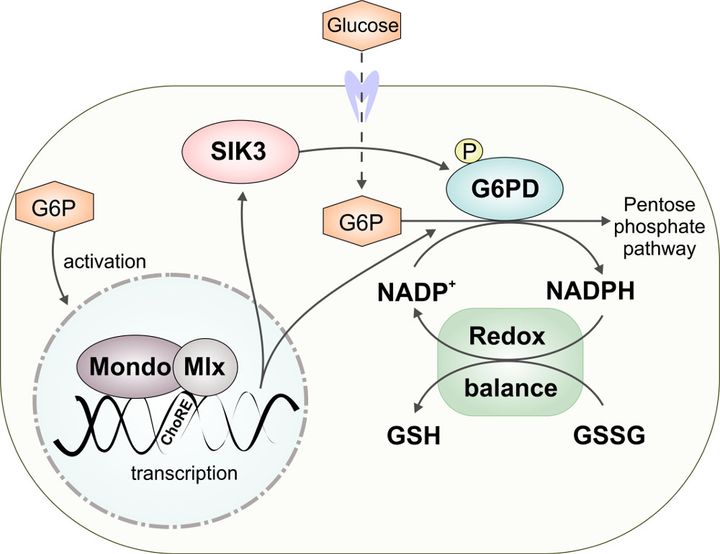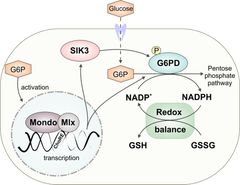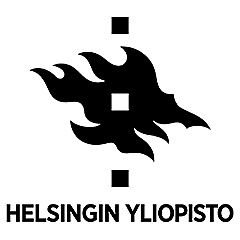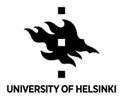Safe utilisation of dietary sugars requires dynamic control of redox balance

Animal diet has a tremendous natural variation, ranging from meat-eating carnivores to sugar-loving nectarivores. Omnivores, like humans, can adopt different types of diets and still remain healthy. However, if the diet is highly unbalanced and calorie rich, it will eventually lead to metabolic problems and disease. The genetic factors of the individual define how easily and quickly such problems develop.
"A key to the nutritional flexibility of the animals is the ability of the body to monitor its nutrient status and regulate metabolism accordingly. Many metabolic pathways depend on reduction and oxidation (redox) reactions. That is why coordinating the redox balance with cellular metabolism is critical", describes Associate Professor Ville Hietakangas from the University of Helsinki, Finland.
The system how the redox balance is controlled in response to changes of sugar feeding has so far been insufficiently understood. Now the study by Mari Teesalu, Bohdana Rovenko and Ville Hietakangas reveals a new mechanism that allows animals to increase their reductive power during conditions of high sugar intake.
"This reductive power is necessary to allow conversion of excess sugar into fat and provide protection against oxidative stress that can occur during sugar metabolism. Without the mechanism to increase the reductive power after sugar feeding larvae of fruit fly Drosophila melanogaster lose their sugar tolerance, and they are not able to grow and survive on high sugar diet", says Hietakangas.
The new regulatory mechanism involves protein kinase SIK3, which controls the activity of other proteins by phosphorylating them. SIK3 phosphorylates and activates a key enzyme of glucose metabolism called Glucose-6-phosphate dehydrogenase G6PD, which is an important regulator of cellular redox balance.
SIK3 controls G6PD in synergy with another important regulator of sugar tolerance, the sugar-sensing transcription factor complex Mondo-Mlx. Simultaneous inhibition of SIK3 and Mondo-Mlx leads to devastating consequences, causing lethality even on moderate levels of dietary sugar.
_________________________
Teesalu et al., Salt-Inducible Kinase 3 Provides Sugar Tolerance by Regulating NADPH/NADP+ Redox Balance, Current Biology (2016), http://dx.doi.org/10.1016/j.cub.2016.12.032
Keywords
Contacts
Associate Professor Ville Hietakangas
Department of Biosciences & Institute of Biotechnology
University of Helsinki
ville.hietakangas@helsinki.fi
+358 2941 58001
@HietakangasLab
Science Communicator Elina Raukko
elina.raukko@helsinki.fi
te. +358 50 318 5302
Images

Links
About Helsingin yliopisto
 Helsingin yliopisto
Helsingin yliopistoPL 3
00014 Helsingin yliopisto
02941 22622 (mediapalvelu) 02941 911 (vaihde) (vaihde)https://www.helsinki.fi/fi/yliopisto
Helsingin yliopisto on yli 40 000 opiskelijan ja työntekijän kansainvälinen yhteisö, joka tuottaa tieteen voimalla kestävää tulevaisuutta koko maailman parhaaksi. Kansainvälisissä yliopistovertailuissa Helsingin yliopisto sijoittuu maailman parhaan yhden prosentin joukkoon. Monitieteinen yliopisto toimii neljällä kampuksella Helsingissä sekä Lahden, Mikkelin ja Seinäjoen yliopistokeskuksissa. Lisäksi sillä on kuusi tutkimusasemaa eri puolilla Suomea ja yksi Keniassa. Yliopisto on perustettu vuonna 1640.
Subscribe to releases from Helsingin yliopisto
Subscribe to all the latest releases from Helsingin yliopisto by registering your e-mail address below. You can unsubscribe at any time.
Latest releases from Helsingin yliopisto
Tutut maatalousympäristön linnut vähenevät, eteläiset yleislajit runsastuvat30.6.2025 08:00:00 EEST | Tiedote
Moni tuttu lintulaji harvinaistuu entisestään. Varpusia ja kuoveja on nyt vähemmän kuin koskaan aiemmin. Toisaalta monien eteläisten lajien voittokulku jatkuu. Mustarastaita ja peukaloisia esiintyy ennätysmäisen runsaasti.
Panimoteollisuuden sivuvirroista terveellisiä elintarvikkeita27.6.2025 13:02:54 EEST | Tiedote
Helsingin yliopiston tutkijat ovat keksineet innovatiivisen ja kestävän tavan hyödyntää mäskiä ja muita panimoteollisuuden sivutuotteita muokkaamalla niistä hyödyllisiä elintarvikkeita.
Mielenterveyden häiriöt koskettavat valtaosaa suomalaisista26.6.2025 08:30:00 EEST | Tiedote
Arviolta 77 % naisista ja 70 % miehistä saa elämänsä aikana jonkin mielenterveyden, käyttäytymisen tai neurokehityksen häiriön diagnoosin. Yleisimmät häiriöt ovat ahdistuneisuus- ja mielialahäiriöt. Miehillä häiriö todetaan useimmiten ensimmäisen kerran jo 6-vuotiaana.
Maahanmuuttajataustaisilla pojilla suurempi riski masennus- ja ahdistusoireiluun – koululla on tärkeä rooli heidän tukemisessaan26.6.2025 08:00:00 EEST | Tiedote
Maahanmuuttajataustaiset lapset ja nuoret raportoivat useammin masennus- ja ahdistusoireita. Oireilta suojaavissa tekijöissä korostuu koulun ja läheisten ihmissuhteiden rooli nuoren elämässä.
Kuinka saada irti kuolleen hirven etuhampaat?23.6.2025 10:36:14 EEST | Tiedote
Uusi tutkimus selvittää, kuinka kivikautiset ihmiset hankkivat raaka-aineen hammasriipuksiin.
In our pressroom you can read all our latest releases, find our press contacts, images, documents and other relevant information about us.
Visit our pressroom